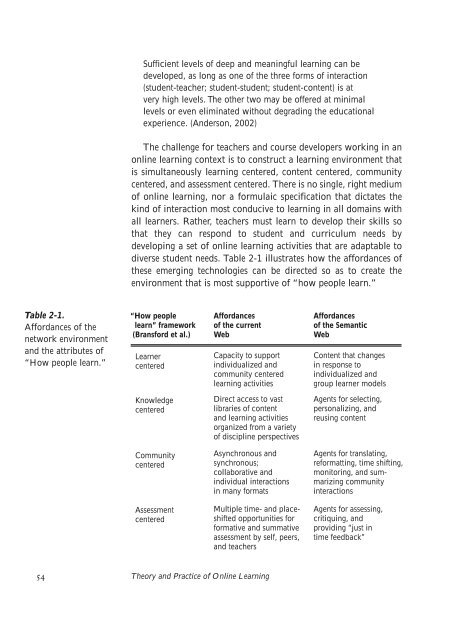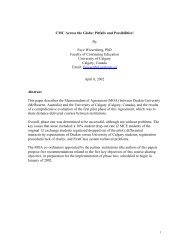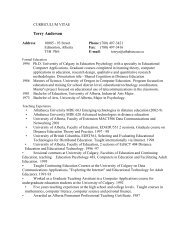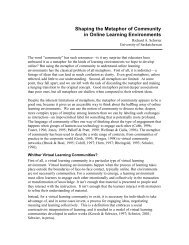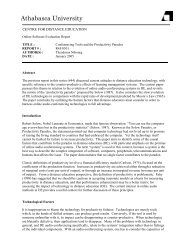Toward a Theory of Online Learning - Centre for Distance Education ...
Toward a Theory of Online Learning - Centre for Distance Education ...
Toward a Theory of Online Learning - Centre for Distance Education ...
You also want an ePaper? Increase the reach of your titles
YUMPU automatically turns print PDFs into web optimized ePapers that Google loves.
Sufficient levels <strong>of</strong> deep and meaningful learning can bedeveloped, as long as one <strong>of</strong> the three <strong>for</strong>ms <strong>of</strong> interaction(student-teacher; student-student; student-content) is atvery high levels. The other two may be <strong>of</strong>fered at minimallevels or even eliminated without degrading the educationalexperience. (Anderson, 2002)The challenge <strong>for</strong> teachers and course developers working in anonline learning context is to construct a learning environment thatis simultaneously learning centered, content centered, communitycentered, and assessment centered. There is no single, right medium<strong>of</strong> online learning, nor a <strong>for</strong>mulaic specification that dictates thekind <strong>of</strong> interaction most conducive to learning in all domains withall learners. Rather, teachers must learn to develop their skills sothat they can respond to student and curriculum needs bydeveloping a set <strong>of</strong> online learning activities that are adaptable todiverse student needs. Table 2-1 illustrates how the af<strong>for</strong>dances <strong>of</strong>these emerging technologies can be directed so as to create theenvironment that is most supportive <strong>of</strong> “how people learn.”Table 2-1.Af<strong>for</strong>dances <strong>of</strong> thenetwork environmentand the attributes <strong>of</strong>“How people learn.”“How peoplelearn” framework(Brans<strong>for</strong>d et al.)LearnercenteredAf<strong>for</strong>dances<strong>of</strong> the currentWebCapacity to supportindividualized andcommunity centeredlearning activitiesAf<strong>for</strong>dances<strong>of</strong> the SemanticWebContent that changesin response toindividualized andgroup learner modelsKnowledgecenteredDirect access to vastlibraries <strong>of</strong> contentand learning activitiesorganized from a variety<strong>of</strong> discipline perspectivesAgents <strong>for</strong> selecting,personalizing, andreusing contentCommunitycenteredAsynchronous andsynchronous;collaborative andindividual interactionsin many <strong>for</strong>matsAgents <strong>for</strong> translating,re<strong>for</strong>matting, time shifting,monitoring, and summarizingcommunityinteractionsAssessmentcenteredMultiple time- and placeshiftedopportunities <strong>for</strong><strong>for</strong>mative and summativeassessment by self, peers,and teachersAgents <strong>for</strong> assessing,critiquing, andproviding “just intime feedback”54 <strong>Theory</strong> and Practice <strong>of</strong> <strong>Online</strong> <strong>Learning</strong>


